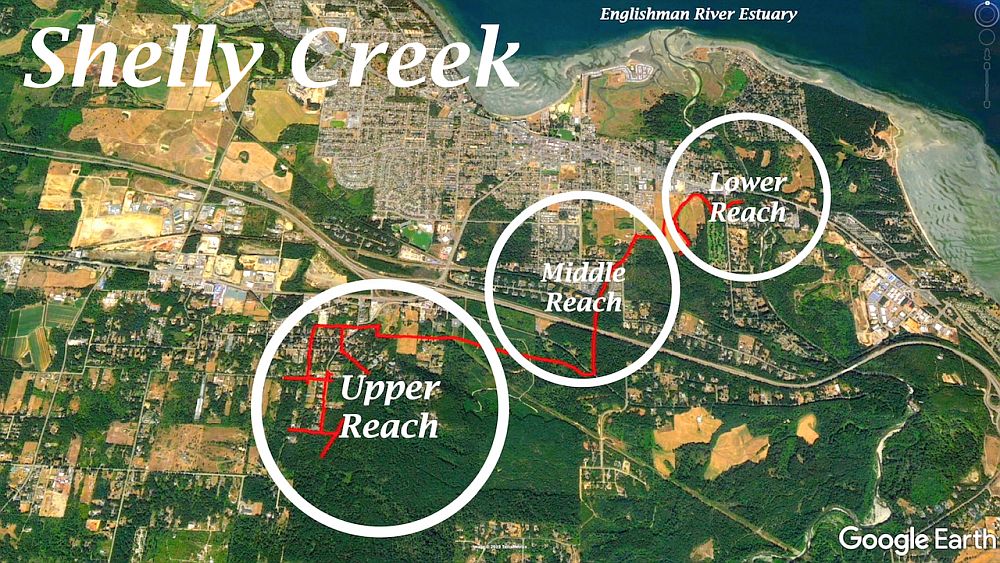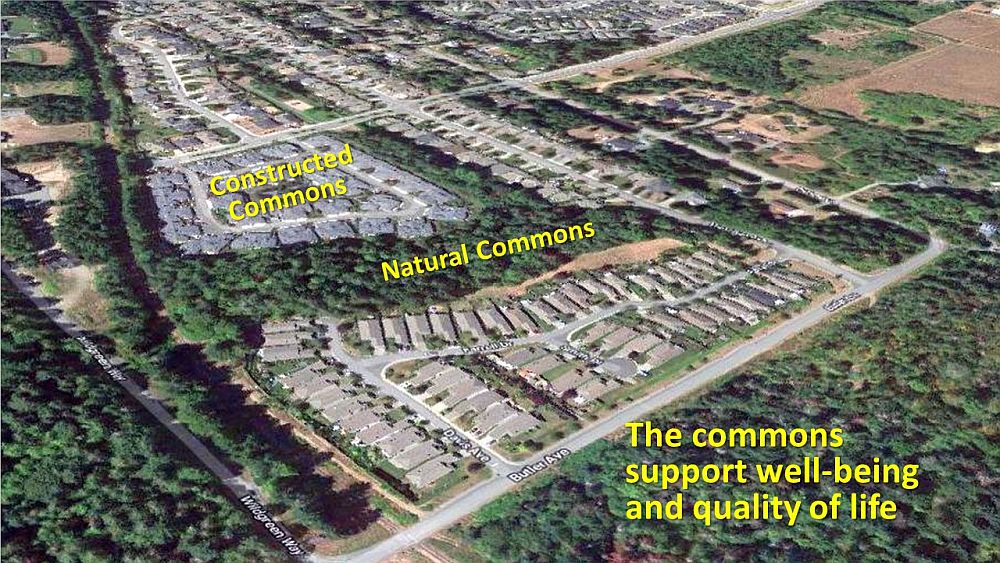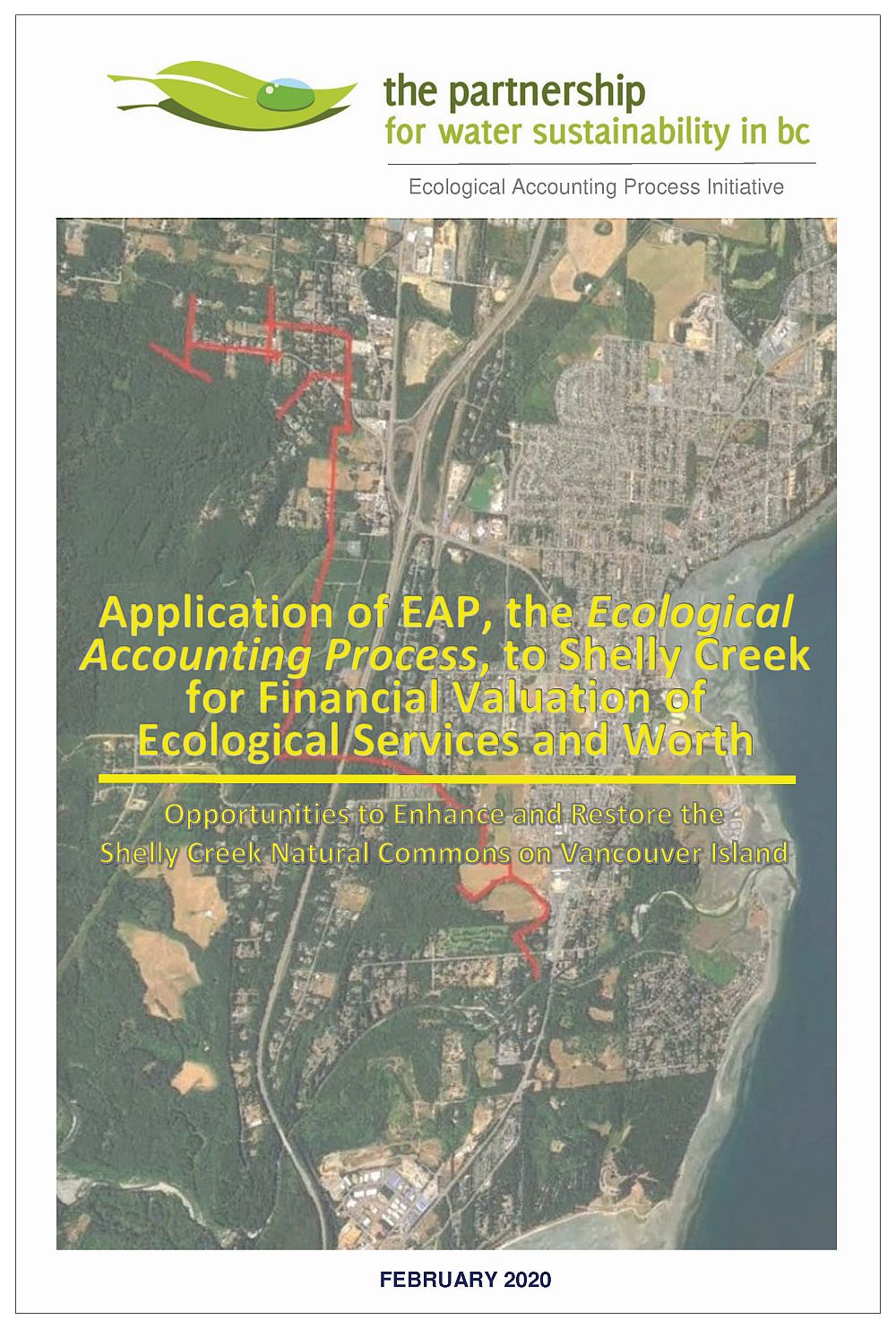FINANCIAL VALUATION OF ECOLOGICAL SERVICES AND WORTH: “As a result of alterations to the hydrology of the creekshed, the Shelly Creek ‘riparian ecosystem’ has been reduced to a number of ‘riparian zones’ as defined in regulations. We view this finding as one of the key takeaways from the Shelly Creek demonstration application of the Ecological Accounting Process,” stated Tim Chair, EAP Chair
Note to Reader:
In April 2020, the Partnership for Water Sustainability in British Columbia released Application of EAP, the Ecological Accounting Process, to Shelly Creek for Financial Valuation of Ecological Services and Worth. This case study was undertaken in collaboration with MVIHES, the Mid Vancouver Island Habitat Enhancement Society. Over time, MVIHES has morphed from Stewards of the Englishman River Recovery Plan to Stewards of the Englishman River Watershed. Since 2011, the MVIHES action plan has concentrated on Shelly Creek.

Application of EAP to Shelly Creek for Financial Valuation of Ecological Services and Worth
The Partnership for Water Sustainability in British Columbia, MVIHES) Mount Arrowsmith Biosphere Reserve Research Institute (MABRRI), and Regional District of Nanaimo Drinking Water & Watershed Protection program (DWWP) collaborated to apply the Ecological Accounting Process (EAP) to Shelly Creek.
The stream, which lies in the Regional District of Nanaimo and the City of Parksville, is a short tributary of the Englishman River, a watershed in the Nanaimo Lowland Eco-region.
Focus on the ‘No Harm’ Rule
 “The Ecological Accounting Process (EAP) considers use and conservation of land to be equally important values. Historically, land use and property development in our communities have been given priority over ecological systems such as streams. Too often the result has been remnant ecological services that fall far short of the benefits that these natural commons can provide,” states Tim Pringle, EAP Chair.
“The Ecological Accounting Process (EAP) considers use and conservation of land to be equally important values. Historically, land use and property development in our communities have been given priority over ecological systems such as streams. Too often the result has been remnant ecological services that fall far short of the benefits that these natural commons can provide,” states Tim Pringle, EAP Chair.
“The research findings suggest that the diminution of stream functions gradually will draw the attention of property owners and the community to the ‘no harm’ rule in land appraisal. To over simplify, in the case of a stream (natural commons) adjacent property owners expect its ecological services to have a positive effect on parcel values.
“The community may rely on the stream system being in good functioning condition as a feature in parks, a natural area, etc. Adjacent property owners have an obligation to recognize these values and avoid activities on their property that might harm the stream and have a negative impact on parcel values.”

Shelly Creek Natural Commons
“Shelly Creek presented an opportunity to delve into the community’s growing appreciation of the worth of this small (1st order) stream. The EAP analyses investigated the understanding that the community (property owners, residents, local government, NGOs and others) have of the stream as a natural commons,” Tim Pringle reports.
“Does awareness of the stream as a natural commons lead to taking action to protect it? Moreover, do purchasers and owners of residential parcels near the stream think that it provides positive influence on property values and other benefits?
“As a result of alterations to the hydrology of the creekshed, the Shelly Creek ‘riparian ecosystem’ has been reduced to a number of ‘riparian zones’ as defined in regulations. This distinction has significant implications, and is something not usually thought about. We view this finding as one of the key takeaways from the Shelly Creek demonstration application of the EAP methodology and process; such that it is necessary to draw attention to this very important distinction.”
Riparian Ecosystems versus Riparian Zones
“EAP analyses now emphasize the distinction between ‘riparian ecosystems’ and ‘riparian zones’. The former is a holistic frame of reference. The latter are a consequence of fragmentation of the landscape. In British Columbia, history shows that the distinction between an ecosystem and a zone is often not well understood. The distinction is appreciated only by a handful of stream practitioners, in particular Peter Law, formerly a Senior Biologist in the Ministry of Environment,” explains Tim Pringle.
 “An alternative term, riparian network, could also be used to describe a system composed of a physical stream channel and adjacent riparian (vegetated) corridor. This system provides a critical ecological function in linking terrestrial and aquatic ecosystems in a watershed or creekshed,” continues Peter Law, MVIHES President.
“An alternative term, riparian network, could also be used to describe a system composed of a physical stream channel and adjacent riparian (vegetated) corridor. This system provides a critical ecological function in linking terrestrial and aquatic ecosystems in a watershed or creekshed,” continues Peter Law, MVIHES President.
“A common history of land uses on the east coast of Vancouver Island and other regions in BC has been the fragmentation of the riparian network in both rural and urbanizing landscapes. Over decades of disturbance, a landscape’s ecological links/services decline as it’s economic (land use) linkages increase. Thus, a descriptive way to visualize these outcomes is this: riparian ecosystems (networks) have become reduced to riparian zones as shown on the maps of today.”

Another Distinction is “Maintenance versus Enhancement”
“EAP presents a study of this diminution as a loss of the riparian network’s ecological services that the natural commons provides for nature, as well as for residents, property owners and others in the community,” adds Tim Pringle.
“The analyses also describe the actions that intervenors undertake to improve ‘maintenance and management’ (M&M) of streams systems and riparian zones. EAP defines maintenance as preventing degradation; and management means enhancement.”
Applied Definitions
In a financial valuation context, the following definitions were developed by Tim Pringle and Peter Law for the Shelly Creek case study application of the EAP methodology. These definitions have universal application.
Riparian Ecosystem Defined
A riparian ecosystem describes a natural stream which is a defined entity, and is sustained by rainfall falling on upland areas – water that is intercepted and detained by vegetation and soils, infiltrated through surface and sub-soils, gradually moving to groundwater, and then to the stream itself.
Riparian Zone Defined
A riparian zone is a fragmented portion of the riparian network in developed areas where land uses have reduced the riparian area to the channel width plus a regulated setback each side (typically 15 metres).
Worth of the Creekshed
“The concept of worth refers to the uses the community draws from the creekshed. This perspective leads to a fuller understanding of the social, ecological and financial values associated with those uses,” states Tim Pringle.
“The stream does more than provide services to the community. It is part of the hydrology of the creekshed. In proper functioning condition the stream underpins intrinsic natural services such as environments for aquatic and terrestrial life.”
To Learn More:
DOWNLOAD A COPY OF: “Shelly Creek Financial Valuation of Ecological Services and Worth“


